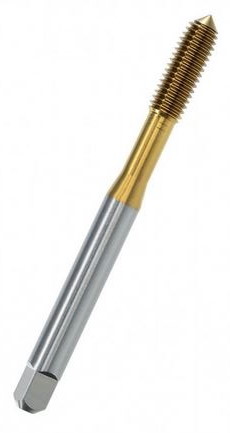- Metric Thread
- Metric Thread - Bolt Torque table
- Metric Thread - Pitch
- Metric Thread - Tap Drill table
- Metric Thread - Clearance Hole table
- Metric Fine Thread - Bolt Torque table
- Metric Fine Thread - Pitch
- Metric Fine Thread - Tap Drill table
- Metric Wrench Sizes
- Sheet Metal Screws Pilot Hole Sizes
- Cable Gland Sizes
- Trapezoidal Thread Sizes
- Cutting Metric Thread
- Inch Thread
- The Screw
- Drill correctly
- Which Dowel
- Materials
- Language
Thread Forming Tap
The thread former is a tool for the non-cutting production of internal threads. The tap is used in a similar way to a tap drill. The difference is that a tap, as
the name suggests, cuts the thread and chips are also produced during the cutting process. In the case of the tap, the thread is created by deformation without cutting.
Thread Former advantages and disadvantages

Advantages:
- No chips
- Longer tool life than a tap
- Higher speed, therefore higher processing speed
- Smooth material surface after processing
- The material fibre flow is not interrupted
- High precision possible.
Disadvantages:
- Higher demands on the drill hole tolerances
- Higher heat generation than during cutting
- With many materials the use is not possible
- Tap as hand tool badly possible
- Frequently a release agent must be used.
Core hole chart for thread former
|
Metric Thread Sizes |
Metric Thread former Core hole diameter (mm) |
Metric Thread Pitch coarse thread (mm) |
| M1 | 0,88 | 0,25 |
| M1,1 | 0,98 | 0,25 |
| M1,2 | 1,08 | 0,25 |
| M1,4 | 1,25 | 0,30 |
| M1,6 | 1,45 | 0,35 |
| M1,8 | 1,65 | 0,35 |
| M2 | 1,80 | 0,40 |
| M2,2 | 2,00 | 0,45 |
| M2,5 | 2,30 | 0,45 |
| M3 | 2,80 | 0,50 |
| M3,5 | 3,25 | 0,60 |
| M4 | 3,70 | 0,70 |
| M5 | 4,65 | 0,80 |
| M6 | 5,55 | 1,00 |
| M7 | 6,55 | 1,00 |
| M8 | 7,40 | 1,25 |
| M9 | 8,40 | 1,25 |
| M10 | 9,25 | 1,50 |
| M12 | 11,20 | 1,75 |
| M14 | 13,10 | 2,00 |
| M16 | 15,10 | 2,00 |
| M18 | 16,90 | 2,50 |
| M20 | 18,90 | 2,50 |
* All information without guarantee.
The following topics may also be of interest to you:
